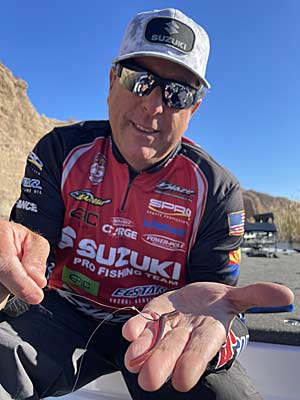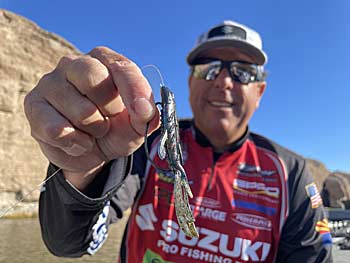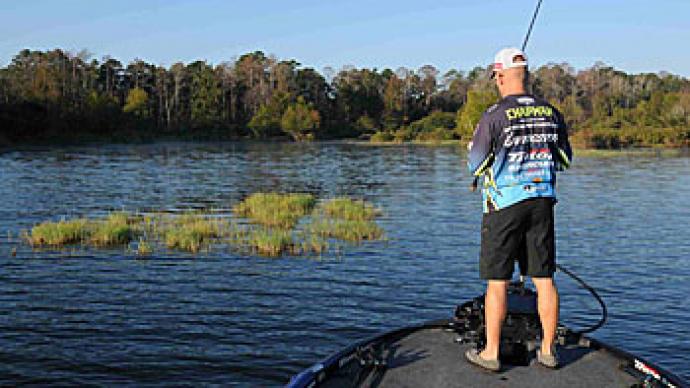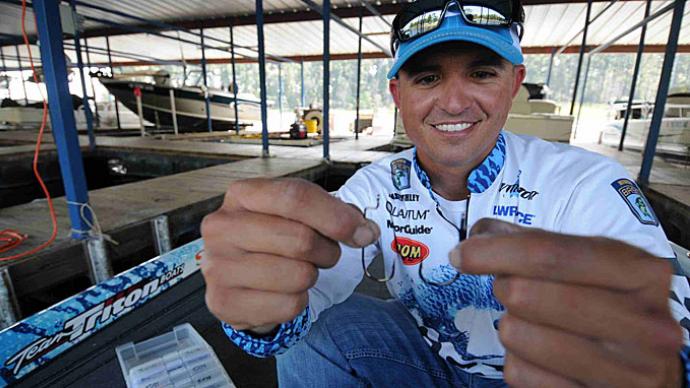
The fishing hook is an age-old way to catch fish and one of the essential bass fishing tools. Over the years, they have evolved from simple designs made of bone and other materials into the advanced hooks we use today. Modern hooks are incredibly sharp and come in different designs but still do the same thing as they did in the early days: hook fish.
When choosing the right hook for the job, there are many factors to consider, and some of them also come down to personal preference. Major League Fishing pro Dean Rojas has been at the top level of pro fishing for years and keeps his hook selection relatively simple to land more bass.
Treble Hooks
Rojas utilizes the round bend style of hooks exclusively on the subject of reaction baits like crankbaits, jerkbaits, and topwaters.
"There are some Extra Wide Gap and other designs, but feel the round bend allows you to hook and land more fish," he says. "That's my preference, but I feel it is the best option. I'll use the nickel or bronze color, depending on what I have. I don't think the fish get a good enough look at the color of the treble hook for it to make a difference."
One thing he will do on occasion is to use one size of hook larger than what comes on the baits.
"Most baits are balanced from the factory for a certain size of hook," he begins. "But, often, they are a little on the smaller size. I'll either swap out the hooks for the same size or go up one size larger."
The Every Day Hook Style
Dean Rojas couldn't live without one hook style, the Extra Wide Gap, a standard among many anglers fishing soft plastic lures.

"I use that for probably 90% of my fishing with soft plastics," he says. "I'll use that style of hook for Texas-Rigs, flipping, pitching, and even some drop-shot fishing. I've used that particular hook since its release and have had great success with it."
His reasoning for choosing this hook style is that the wide gap allows for the best hookups.
"The actual design of the hook keeps them better, in my opinion," Rojas shares. "I'll also open the hook up a little more with some pliers. The more space between the hook eye and hook point, the better. When you fight a fish, that's one less thing to get in the way."
Rojas will use smaller versions of this hook for fishing a drop-shot around cover while Texas-Rigging the bait.
"A small 1/O or 2/O Gamakatsu Extra Wide Gap is good for a Texas-Rigged finesse worm on a drop-shot rig when fishing around grass and brush," Rojas shares. "For open water drop-shotting, I'll use a Size 1 Gamakatsu Aaron Martens TGW Drop Shot Hook. It is super sharp, light, and strong. It also has a smooth nano-coating that helps to get better hook penetration."
Another variable that Rojas considers is the worm he uses from drop-shot fishing.
"There are a lot of variations for how thick the plastic is," he shares. "If you have a fatter worm and small hook, you can impede the hook from penetrating through enough to get solidly into a fish's mouth. That's also a factor when I decide what size of hook to use for all soft plastic baits."
Rojas on Hook Sizing
On average, Rojas prefers to go with a bigger hook to increase his odds of keeping fish pinned. He also adjusts his hook size and thickness to change how a lure falls.
"Much of my process on selecting the right hook comes down to the conditions," Rojas begins. "On a bait like a soft-stickbait, using a heavier hook or bigger hook will allow you to fish it even in windier conditions. I'll also go to the Superline version of the Extra Wide Gap to get that faster fall or fishing in the grass so it will sink through better. Baits like that can also be harder to cast if you use smaller hooks or ones that are too thin."
When fishing fluke-style baits, he'll adjust his hook size based on the conditions and how fast he wants the bait to fall.

"The good thing about that style of bait is that the bait cradles the hook, and you can get away with a bigger hook," he shares. "I'll use either a 5/O or 6/O if I can. As a general rule, as long as your hook doesn't impede the action of a bait, you are fine."
When pitching and flipping, he again uses the Extra Wide Gap style of hooks. A lure he designed was built specifically for the hook. The Big Bite Baits Dean Rojas Fighting Frog can be rigged on various hook styles, but Rojas made the beaver-style creature bait with the EWG in mind.
"I'll use a 4/0 or 5/O on the bigger version because once a fish eats the bait, you are going to land them," he says. "On the smaller ones, I'll use a 4/0, and it won't impede the action as it goes through the water."
When fishing a Texas-Rig with standard worms and finesse worms, Rojas will again use the Extra Wide Gap style and adjust the sizing based on the worm's length and thickness.
Out of all the hooks and styles available to bass anglers, it is refreshing that a top professional angler like Dean Rojas relies on a small handful of different hooks. His thought process on hook designs is to keep things simple and use what works for the bait you are using while also using what you have confidence in.




